
I remember getting my first tattoo so vividly – the course of adrenaline, my awkward, freshly out of high school self, swooning over the gruff artist who was to do the quarter-sized apple behind my ear, the shock of that first bite of gun into flesh, and the memory of the way the gun buzzed along my skull, so loud next to my ear.


I love tattoos. I mean sure, piercings are great, but if I’m really being honest, I’ll take tattoos instead any day of the week. There’s so much power behind deciding on something that’s going to be on your body the rest of your life, choosing and knowing how to define yourself, and being that confident in knowing exactly who you are. It’s freeing.
For all of my experience with them now though, I remember a time when I was pretty freaked out by them. I had all of the usual worries:
How bad is it going to hurt?
Will I hate this in a few years?
Will I ever be able to get a respectable job?
Oh to be young and me – so much anxiety over such petty things. But in all seriousness, tattoos are forever, so it’s important to really get to know the process – and yourself – before you go under the gun. If I could travel back in time, here are a few things I’d tell virgin-skinned Destiny.
When we’re nervous about something, every nerve ending we have is on red alert, so all too often, we work ourselves up about how much a new tattoo is going to hurt, and as a result, it hurts more than it should – so much of it is psychosomatic.
So for starters, take a goddamned deep breath, and buck up, because everyone makes fun of the person that cries through their tattoo. You can totally do this, and the pain is only as bad as you build it up to be.
Whatever you do though, don’t drown your anxiety in booze. Alcohol is a blood-thinner, aside from just being a judgment affecting beverage, and you absolutely will bleed more if you drink first, which is going to slow down your artist. Do some yoga, go on a walk, but don’t reach for the whiskey.
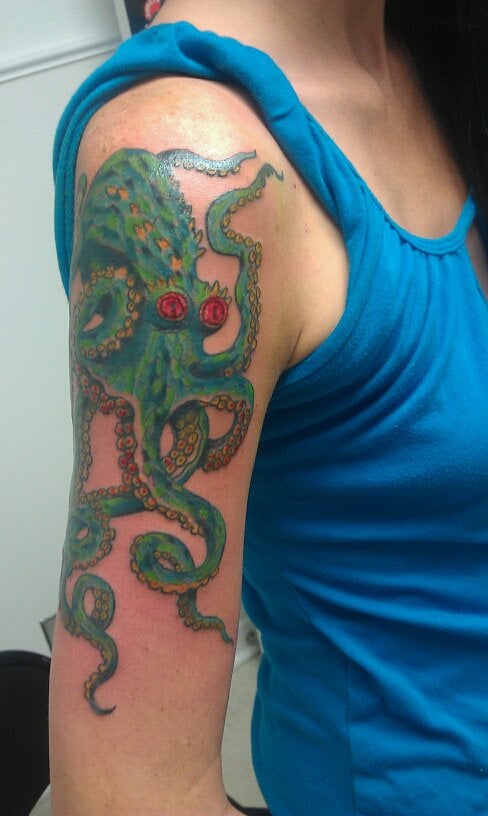
Some areas are definitely more painful than others to have tattooed. I have a 3/4 sleeve, a tattoo behind my ear, sparrows on my hips, and a lotus design under my breasts along my sternum, and I can definitely say that the most painful work I had done was long my sternum, right under my breasts, and my elbow, which is fully tattooed.
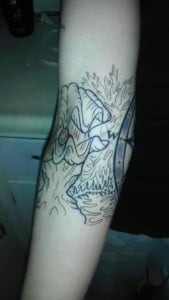
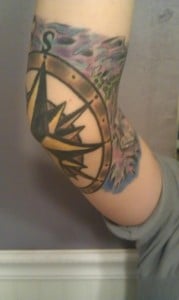
Six hours under the gun in one bony spot like that – I don’t recommend it. I could barely speak by the end of my session.
For the most part, the pain lessens after the first 30 minutes or so into a session – your muscle tissue adjusts to the vibration of the tattoo gun, and while you can still feel it, your endorphin rush does a ton of the work, and you notice it way less. I know next time I get a tattoo, I’m just going to bring my laptop, so I can work right through my session.
However, when it comes to bony areas, there isn’t much shock absorption between the bouncing of that needle and your bones, and what you wind up with is persistent, intense pain. I always kind of laughed at the rib cage tattoo trend that was so popular a few years ago, because it seemed everyone was making that their first tattoo, and it was by far and away one of the most painful places to be tattooed.
I remember sitting in a chair in my favorite shop, having some work done on my sleeve, and for two or three hours, watching a girl walk past with her sweatshirt over her chest, sobbing, fresh ink outlined in red, puffy flesh adorning her ribs.
Don’t let the pain influence where you get your first tattoo. I know that statement might seem contradictory to my warnings about pain above, but the bottom line is, pain is fleeting – it’s not going to last forever, but your tattoo will. If you absolutely have to have a phoenix on your rib cage, if it’s a part of who you are, then don’t let something as silly as intense pain get in the way – be a rock star, and do it anyway.
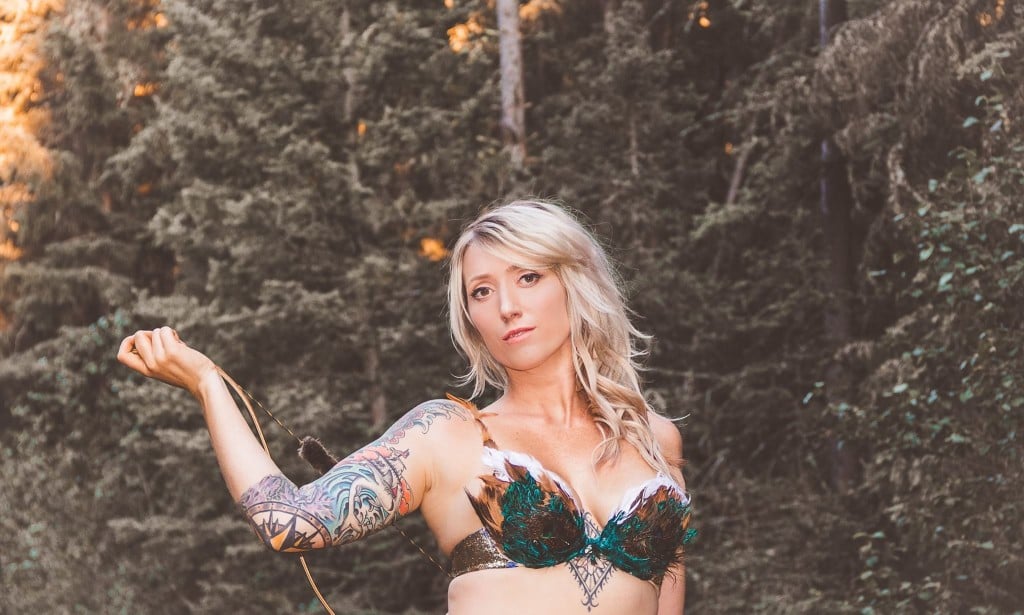
My sternum tattoo took two sessions, because there were some heavy black lines that needed a bit of touch up a few weeks later, and I remember how hard it was to come back to the shop for more self-inflicted punishment, but now it’s one of my favorite tattoos, and kind of a signature part of my look – this tattoo helps me to feel more like me, and it was absolutely worth that few hours of topless, bone-rattling agony.

After I endured that bone-rattling pain of having my sternum tattooed, I had a little time and experience to use to reflect on those sessions, and in doing so, realized that I probably didn’t have to be completely topless for the thing. My tattoo artist was very nice, and my boyfriend (now husband) was there the whole time to make sure I was comfortable, but in hindsight, I’m thinking there were ways to cover my tatas, and that maybe things were just a little more entertaining for the artist if we didn’t think too hard about creative ways to cover my boobs.
Oh well, c’est la vie. You live and you learn.
That being said, I see all the time in my local Facebook groups where people are looking for great tattoo artists, and you know what I’ve learned?
Great is relevant. You cannot rely on a stranger’s opinion on the internet to get a feel for an artist’s style, talent, and professionalism.
Do your homework on them – look at their portfolio and see if their style matches up with how you’re envisioning your piece. Many artists have a style that is most natural to them, and their work follows that pattern, so don’t assume that you can go to a traditional artist and get something like a watercolor tattoo.
From there, take note of awesome tattoos you see in public, and don’t be shy – ask total strangers where they had their work done. I’m pleased to say I get asked this all the time, and it’s a sign that someone likes your tattoo so much, they want to go to the same artist, so trust me, you’re not going to offend anyone.
After you’ve gotten a feel for their work, stop by the shop to talk to them about your ideas, but also to scope the place out. Is it clean? Do you feel comfortable there? Are the artists friendly and open to your thoughts? Don’t get stuck with someone who thinks that their pleasure in an artform trumps what you want on your body for the rest of your life – they make a good living, and should definitely be receptive to their clients’ ideas.
That being said, the very fastest way to piss off a tattoo artist (or any creative professional for that matter), is to insult them by degrading the value of their work. Always ask about what a tattoo is going to cost, but keep in mind that this cost is relative to the time input of your tattoo, and is just that – an estimate.
In my experience, most tattoo artists charge between $75 and $125 an hour. I’ve seen more experienced artists with full bookings charge $175 an hour, so don’t be turned off by higher rates. With tattoos, you almost always get what you pay for.
Like anyone else working, your artist will likely take breaks during your session. Personally, I’m okay with a ten-minute break every hour, and a break for lunch for particularly long sessions over four hours. If they’re disappearing every half hour for 15 minutes though, that’s where I’d draw a line in the sand. Do what you have to do to keep the relationship amicable, but don’t let them extort you just because they’re going into nicotine withdrawals.
I always do. It’s just a way of saying, ‘Man, this is exactly what I wanted, and way beyond my expectations, and so I’m rounding this bill up to the nearest $100.’ After all the money you’re going to spend on tattoos, it may seem painful to part with more, but the way I see it, they’re offering a creative service, and it’s hard to put an exact value on some of the beautiful work they’re producing.
If you love it, at least cover their lunch. If you weren’t really digging their attitude or the tattoo isn’t great, like with any other service, don’t feel obligated to tip.
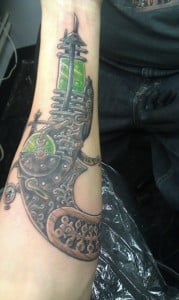
When you first get a tattoo done, it’s going to be swollen and red for a while. Time varies depending on where it is and how well your body recuperates, but I remember it taking a week or two for the redness to go down in more intense areas (my elbow comes to mind). It’ll feel like you have a bad sunburn at first, and it’s likely you’ll have some muscle aches, in part due to tension during your session, but also just from that gun bouncing around on your flesh – it can be a bit exhausting.
Your artist will clean the area well, moisturize it, and then wrap it in plastic wrap, taping the ends. I usually left the plastic wrap on for the first 12 hours, then changed it in the morning. How long you keep it covered like this could very well depend on what your activities throughout the day are like.
During my fresh tattoo days, I worked with animals, around a lot of hair and bacteria, so I wrapped my tattoo in plastic for at least a week while at work, only taking it off at home, then wrapping it again at night. The plastic will keep the foreign objects out of your tender skin, but also helps to seal in moisture.
After that, just keep it clean, washing once or twice a day with antibacterial soap, and moisturizing frequently. At the time I just used Aquaphor, but there are a lot of other great aftercare products out there that are specifically designed for this kind of healing. I’ve heard really great things about Tattoo Goo, and H2Ocean’s stuff is supposed to work really well.
You can snag a simple tattoo aftercare kit from H2Ocean with everything you need here.
It’s not common, but in a shop without sterile tools or a poor aftercare routine, you can wind up with an infection. Here’s the thing to remember: Tattoos are supposed to heal.
If you notice any discoloration at all, excessive swelling (anything past a couple of weeks is cause for concern), or get a fever, go to the urgent care center right away. Infections can get serious quickly, and if not diagnosed and treated, can quickly lay you up in bed.
If you have particularly sensitive skin, keep an eye for signs of allergies to the ink, and talk to your artist about what’s in what they’re using. Though rare, some people find they have adverse reactions to some formulas, and some colors can be more troublesome than others. Fun fact: red is the smallest color molecule and penetrates the deepest into skin and hair. If you’re going to have an ink allergy, it’s probably going to involve red.

If there’s one last piece of advice I can offer you, it’s to not give a diggity-damn what people say about your tattoos. I have had so many insults hurled my way, so many warnings about getting a job, aging, what my kids will think, and you know what? I decided I didn’t really give a shit. And it felt awesome.
Do you want it? Is it a timeless piece? Is it going to make your heart sing and set your soul on fire? Then do it, and tell those naysayers to stick it where the sun don’t shine.
What’s that going to look like in 30 years? Well, probably old and wrinkly, just like the rest of me, you effing moron.
Here’s the reality of getting, having, and living the rest of your life with tattoos:

Don’t let anyone hold you back – life is too short to wait to get tattoos.
One Reply to “Getting Your First Tattoo – What You Need to Know”
James Borst, 19 Nov 2019
It is interesting that experienced artists with full bookings cost $175/hour. My wife and I have been married for a couple of years and we’ve considered getting a couples tattoo on our forearm. We may consider looking at different tattoo shops around town to help us decide who to go with.